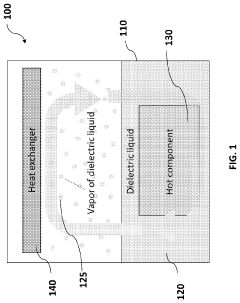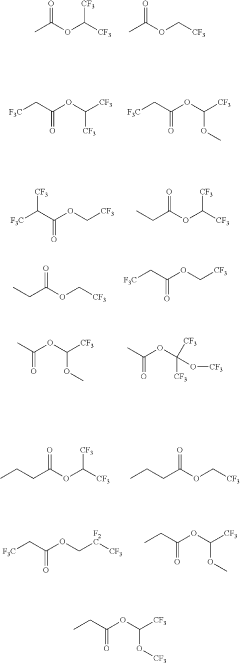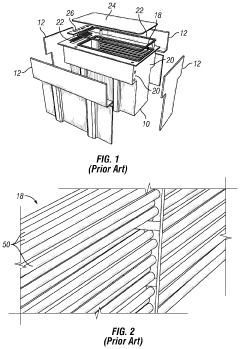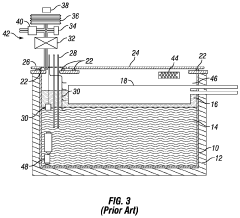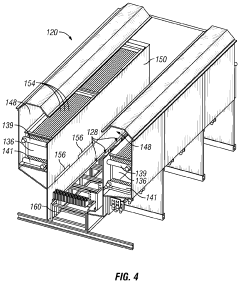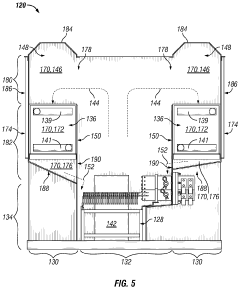Boiling Heat Transfer Fundamentals For Two-Phase Immersion Cooling
AUG 22, 20259 MIN READ
Generate Your Research Report Instantly with AI Agent
Patsnap Eureka helps you evaluate technical feasibility & market potential.
Two-Phase Immersion Cooling Background and Objectives
Two-phase immersion cooling represents a paradigm shift in thermal management technology, evolving from traditional air cooling methods that have reached their practical limits in high-performance computing environments. This cooling approach utilizes the phase change phenomenon of dielectric fluids to efficiently dissipate heat from electronic components. The technology's development can be traced back to the 1980s when it was primarily used in specialized military and aerospace applications, but has gained significant momentum in the past decade due to increasing power densities in data centers and high-performance computing systems.
The fundamental principle behind two-phase immersion cooling involves submerging electronic components directly in a dielectric fluid with appropriate boiling characteristics. As components generate heat, the fluid absorbs this thermal energy, transitions from liquid to vapor state at the component surface, rises, condenses at a condenser, and returns to the liquid pool—creating a highly efficient natural circulation cooling cycle.
Recent technological advancements have focused on optimizing fluid properties, enhancing surface characteristics for improved nucleate boiling, and developing more efficient condenser designs. The evolution of this technology has been driven by the exponential growth in computing power and the corresponding increase in heat flux densities, which conventional cooling methods struggle to manage effectively.
The primary objective of investigating boiling heat transfer fundamentals for two-phase immersion cooling is to establish a comprehensive understanding of the complex thermophysical processes involved. This includes characterizing bubble nucleation dynamics, quantifying heat transfer coefficients under various operating conditions, and developing predictive models that can accurately simulate system performance.
Additional goals include identifying optimal surface treatments and geometries that enhance nucleate boiling, determining the most suitable dielectric fluids for specific applications, and establishing design guidelines for efficient two-phase cooling systems. These objectives align with the broader industry need for cooling solutions that can support the next generation of high-density computing while minimizing energy consumption.
The technology aims to address critical challenges in thermal management, including the need for higher cooling capacity, reduced energy consumption, smaller footprint, and enhanced reliability compared to traditional cooling methods. Understanding the fundamental heat transfer mechanisms will enable the development of more efficient cooling systems capable of handling heat fluxes exceeding 100 W/cm², which is increasingly common in advanced computing applications.
By establishing a solid foundation in the boiling heat transfer fundamentals, this research seeks to bridge the gap between theoretical understanding and practical implementation, ultimately facilitating wider adoption of two-phase immersion cooling across various industries.
The fundamental principle behind two-phase immersion cooling involves submerging electronic components directly in a dielectric fluid with appropriate boiling characteristics. As components generate heat, the fluid absorbs this thermal energy, transitions from liquid to vapor state at the component surface, rises, condenses at a condenser, and returns to the liquid pool—creating a highly efficient natural circulation cooling cycle.
Recent technological advancements have focused on optimizing fluid properties, enhancing surface characteristics for improved nucleate boiling, and developing more efficient condenser designs. The evolution of this technology has been driven by the exponential growth in computing power and the corresponding increase in heat flux densities, which conventional cooling methods struggle to manage effectively.
The primary objective of investigating boiling heat transfer fundamentals for two-phase immersion cooling is to establish a comprehensive understanding of the complex thermophysical processes involved. This includes characterizing bubble nucleation dynamics, quantifying heat transfer coefficients under various operating conditions, and developing predictive models that can accurately simulate system performance.
Additional goals include identifying optimal surface treatments and geometries that enhance nucleate boiling, determining the most suitable dielectric fluids for specific applications, and establishing design guidelines for efficient two-phase cooling systems. These objectives align with the broader industry need for cooling solutions that can support the next generation of high-density computing while minimizing energy consumption.
The technology aims to address critical challenges in thermal management, including the need for higher cooling capacity, reduced energy consumption, smaller footprint, and enhanced reliability compared to traditional cooling methods. Understanding the fundamental heat transfer mechanisms will enable the development of more efficient cooling systems capable of handling heat fluxes exceeding 100 W/cm², which is increasingly common in advanced computing applications.
By establishing a solid foundation in the boiling heat transfer fundamentals, this research seeks to bridge the gap between theoretical understanding and practical implementation, ultimately facilitating wider adoption of two-phase immersion cooling across various industries.
Market Demand Analysis for Immersion Cooling Solutions
The immersion cooling market is experiencing unprecedented growth driven by the escalating power demands of high-performance computing systems. Data centers worldwide are facing critical challenges with traditional air cooling methods as rack densities continue to increase beyond 30kW per rack. Two-phase immersion cooling solutions offer a compelling alternative, with the potential to handle power densities exceeding 100kW per rack while significantly reducing energy consumption.
Market research indicates that the global immersion cooling market was valued at approximately $243 million in 2021 and is projected to reach $700 million by 2026, representing a compound annual growth rate of 23.3%. This growth trajectory is primarily fueled by the expansion of hyperscale data centers, cryptocurrency mining operations, and edge computing facilities that require efficient thermal management solutions.
The demand for immersion cooling technology is particularly strong in regions with high electricity costs or warm climates, where the energy efficiency benefits translate to substantial operational cost savings. North America currently leads the market, followed by Europe and the Asia-Pacific region, with China and Japan showing the fastest adoption rates due to their dense urban data center environments.
Industry sectors driving this demand include cloud service providers seeking to optimize their infrastructure efficiency, financial institutions running high-frequency trading algorithms, artificial intelligence research facilities, and cryptocurrency mining operations. These sectors share common requirements for handling extreme computational loads while minimizing energy consumption and physical footprint.
Environmental regulations and corporate sustainability initiatives are creating additional market pull for immersion cooling solutions. With data centers accounting for approximately 1% of global electricity consumption, the potential 30-50% reduction in cooling energy usage offered by immersion systems represents a significant opportunity for organizations to meet carbon reduction targets.
Customer pain points driving adoption include the limitations of air cooling for next-generation processors, space constraints in urban data centers, noise reduction requirements, and the need for more predictable thermal management in variable computing workloads. The elimination of complex air handling equipment also appeals to operators looking to simplify infrastructure management.
Market barriers include the higher initial capital expenditure compared to traditional cooling methods, concerns about liquid handling and maintenance procedures, compatibility issues with existing IT equipment, and the relative immaturity of standards and best practices for immersion cooling implementations. These factors are particularly significant for small to medium-sized enterprises considering adoption.
Despite these challenges, the market shows strong indicators of continued expansion as the technology matures and the performance benefits become more widely documented through case studies and industry benchmarks.
Market research indicates that the global immersion cooling market was valued at approximately $243 million in 2021 and is projected to reach $700 million by 2026, representing a compound annual growth rate of 23.3%. This growth trajectory is primarily fueled by the expansion of hyperscale data centers, cryptocurrency mining operations, and edge computing facilities that require efficient thermal management solutions.
The demand for immersion cooling technology is particularly strong in regions with high electricity costs or warm climates, where the energy efficiency benefits translate to substantial operational cost savings. North America currently leads the market, followed by Europe and the Asia-Pacific region, with China and Japan showing the fastest adoption rates due to their dense urban data center environments.
Industry sectors driving this demand include cloud service providers seeking to optimize their infrastructure efficiency, financial institutions running high-frequency trading algorithms, artificial intelligence research facilities, and cryptocurrency mining operations. These sectors share common requirements for handling extreme computational loads while minimizing energy consumption and physical footprint.
Environmental regulations and corporate sustainability initiatives are creating additional market pull for immersion cooling solutions. With data centers accounting for approximately 1% of global electricity consumption, the potential 30-50% reduction in cooling energy usage offered by immersion systems represents a significant opportunity for organizations to meet carbon reduction targets.
Customer pain points driving adoption include the limitations of air cooling for next-generation processors, space constraints in urban data centers, noise reduction requirements, and the need for more predictable thermal management in variable computing workloads. The elimination of complex air handling equipment also appeals to operators looking to simplify infrastructure management.
Market barriers include the higher initial capital expenditure compared to traditional cooling methods, concerns about liquid handling and maintenance procedures, compatibility issues with existing IT equipment, and the relative immaturity of standards and best practices for immersion cooling implementations. These factors are particularly significant for small to medium-sized enterprises considering adoption.
Despite these challenges, the market shows strong indicators of continued expansion as the technology matures and the performance benefits become more widely documented through case studies and industry benchmarks.
Current State and Challenges in Boiling Heat Transfer
Boiling heat transfer for two-phase immersion cooling has seen significant advancements globally, with research institutions and technology companies making substantial progress in understanding fundamental mechanisms. Currently, the field has established several boiling regimes including nucleate boiling, transition boiling, and film boiling, each with distinct heat transfer characteristics. The nucleate boiling regime, particularly important for immersion cooling applications, has been extensively studied with correlations like Rohsenow's equation providing predictive capabilities for heat transfer coefficients.
Despite these advances, several critical challenges persist in the field. Surface characteristics remain a complex variable affecting boiling performance, with limited understanding of how surface roughness, wettability, and micro/nanostructures interact with different dielectric fluids. The physics of bubble nucleation, growth, and departure in confined spaces typical of electronic cooling environments is not fully characterized, creating gaps in predictive modeling capabilities.
Internationally, research centers in the United States, Japan, Germany, and China lead development efforts, with each region focusing on different aspects of the technology. U.S. research emphasizes high-performance computing applications, while Asian institutions concentrate on consumer electronics cooling solutions. This geographical distribution has created knowledge silos that impede comprehensive understanding of the technology.
Another significant challenge is the limited availability of standardized testing methodologies for two-phase immersion cooling systems. The lack of industry-wide benchmarks makes comparative analysis difficult, hindering technology adoption in commercial applications. Additionally, the thermal interface between electronic components and cooling fluids presents persistent challenges, with contact resistance often limiting overall cooling efficiency.
The dielectric fluids themselves present ongoing challenges, with trade-offs between thermal performance, environmental impact, and cost. Many high-performance fluids have concerning global warming potential or face regulatory restrictions, while more environmentally friendly alternatives often demonstrate inferior thermal characteristics. This creates a significant barrier to widespread adoption.
Critical heat flux (CHF) prediction remains another major technical hurdle, particularly in variable heat load scenarios typical of modern computing applications. Current models struggle to accurately predict CHF in complex geometries and under transient conditions, creating reliability concerns for practical implementations. These limitations collectively represent the frontier of research needs in boiling heat transfer for immersion cooling applications.
Despite these advances, several critical challenges persist in the field. Surface characteristics remain a complex variable affecting boiling performance, with limited understanding of how surface roughness, wettability, and micro/nanostructures interact with different dielectric fluids. The physics of bubble nucleation, growth, and departure in confined spaces typical of electronic cooling environments is not fully characterized, creating gaps in predictive modeling capabilities.
Internationally, research centers in the United States, Japan, Germany, and China lead development efforts, with each region focusing on different aspects of the technology. U.S. research emphasizes high-performance computing applications, while Asian institutions concentrate on consumer electronics cooling solutions. This geographical distribution has created knowledge silos that impede comprehensive understanding of the technology.
Another significant challenge is the limited availability of standardized testing methodologies for two-phase immersion cooling systems. The lack of industry-wide benchmarks makes comparative analysis difficult, hindering technology adoption in commercial applications. Additionally, the thermal interface between electronic components and cooling fluids presents persistent challenges, with contact resistance often limiting overall cooling efficiency.
The dielectric fluids themselves present ongoing challenges, with trade-offs between thermal performance, environmental impact, and cost. Many high-performance fluids have concerning global warming potential or face regulatory restrictions, while more environmentally friendly alternatives often demonstrate inferior thermal characteristics. This creates a significant barrier to widespread adoption.
Critical heat flux (CHF) prediction remains another major technical hurdle, particularly in variable heat load scenarios typical of modern computing applications. Current models struggle to accurately predict CHF in complex geometries and under transient conditions, creating reliability concerns for practical implementations. These limitations collectively represent the frontier of research needs in boiling heat transfer for immersion cooling applications.
Current Boiling Heat Transfer Solutions and Implementations
01 Dielectric fluid compositions for immersion cooling
Specific dielectric fluid compositions are used in two-phase immersion cooling systems to enhance heat transfer efficiency. These fluids have optimized properties such as low boiling points, high dielectric strength, and chemical stability. When electronic components generate heat, the fluid evaporates, carrying heat away through phase change, and then condenses back to liquid form. The selection of appropriate fluid compositions is critical for maximizing cooling performance while ensuring compatibility with electronic components.- Dielectric fluid compositions for two-phase immersion cooling: Specialized dielectric fluid compositions are essential for effective two-phase immersion cooling systems. These fluids are engineered with specific thermal properties to facilitate efficient phase change heat transfer while remaining electrically non-conductive. The compositions may include engineered fluorocarbons, hydrofluoroethers, or other synthetic compounds with optimized boiling points and latent heat characteristics to maximize cooling efficiency while protecting electronic components from electrical shorts.
- Immersion cooling system designs for electronic components: Advanced system designs for two-phase immersion cooling focus on optimizing the physical arrangement of electronic components within cooling baths. These designs incorporate specialized tanks, component mounting structures, and fluid circulation pathways that maximize heat transfer efficiency. Key design elements include proper spacing between heat-generating components, strategic positioning of condensers, and implementation of vapor recovery systems to maintain consistent cooling performance across the entire immersion environment.
- Condensation and fluid circulation mechanisms: Effective two-phase immersion cooling systems require sophisticated condensation and fluid circulation mechanisms to complete the cooling cycle. These mechanisms include specialized condensers that efficiently convert vaporized cooling fluid back to liquid form, along with circulation systems that ensure proper distribution of cooled fluid throughout the immersion environment. Advanced designs may incorporate passive circulation driven by thermal gradients or active pumping systems to optimize heat transfer rates and maintain consistent operating temperatures.
- Thermal management for high-density computing applications: Two-phase immersion cooling solutions specifically designed for high-density computing applications such as data centers, cryptocurrency mining operations, and high-performance computing clusters. These solutions address the extreme heat generation challenges of densely packed servers and specialized computing hardware. The thermal management approaches include custom immersion tanks for server racks, specialized fluid formulations for higher heat loads, and integrated monitoring systems that optimize cooling performance while minimizing energy consumption.
- Enhanced surface technologies for improved heat transfer: Advanced surface modification technologies that enhance the heat transfer efficiency in two-phase immersion cooling systems. These include micro-structured surfaces, specialized coatings, and engineered geometries that promote nucleate boiling and improve thermal interface performance. By optimizing the interaction between the cooling fluid and the heat-generating surfaces, these technologies can significantly increase heat transfer coefficients, reduce thermal resistance, and improve overall cooling system efficiency while potentially reducing the required fluid volume.
02 System design for two-phase immersion cooling
The design of two-phase immersion cooling systems involves specialized components such as condensers, fluid circulation mechanisms, and thermal management structures. These systems typically include sealed enclosures containing electronic components submerged in dielectric fluid, with condensing surfaces to return vaporized fluid to liquid state. Advanced designs incorporate features like flow directors, baffles, and optimized component layouts to enhance convection currents and improve overall heat transfer efficiency.Expand Specific Solutions03 Cooling solutions for high-density computing
Two-phase immersion cooling technologies specifically designed for high-density computing environments such as data centers, AI servers, and cryptocurrency mining operations. These solutions address the thermal challenges of densely packed electronic components by providing more efficient heat removal compared to traditional air cooling. The immersion approach allows for higher power densities, reduced energy consumption for cooling, and potential for heat recovery, making it particularly valuable for high-performance computing applications.Expand Specific Solutions04 Enhanced heat transfer mechanisms
Advanced techniques to improve the heat transfer efficiency in two-phase immersion cooling systems. These include engineered surface structures on heat-generating components, specialized heat spreaders, and enhanced boiling mechanisms. By optimizing nucleation site density, fluid flow patterns, and phase change dynamics, these mechanisms can significantly increase the heat transfer coefficient and cooling capacity of immersion systems, allowing for more effective thermal management of high-power electronic devices.Expand Specific Solutions05 Integrated cooling and power systems
Integration of two-phase immersion cooling with power delivery and management systems to create comprehensive thermal solutions. These integrated approaches combine cooling functionality with power distribution, monitoring, and control systems. By addressing both thermal and electrical requirements in a unified design, these systems offer improved efficiency, reliability, and space utilization. Some implementations also incorporate waste heat recovery mechanisms to further enhance overall energy efficiency.Expand Specific Solutions
Key Industry Players in Immersion Cooling Market
The two-phase immersion cooling market for data centers is in a growth phase, with increasing adoption driven by energy efficiency demands and high-density computing needs. The market is expanding rapidly as companies seek thermal management solutions for advanced computing applications. Technologically, the field is maturing with established players like Intel, Microsoft, and Dell Products developing proprietary solutions, while specialized cooling companies such as Cooler Master and Nuventix advance innovation. Academic institutions including Shanghai Jiao Tong University and Xi'an Jiaotong University contribute fundamental research. Major semiconductor manufacturers like TSMC and technology giants such as Toyota are investing in this technology, indicating its strategic importance across multiple industries as data center thermal management becomes increasingly critical.
Intel Corp.
Technical Solution: Intel has pioneered two-phase immersion cooling technology for high-performance computing applications, focusing on managing thermal challenges in densely packed server environments. Their approach utilizes engineered immersion cooling systems where server components are submerged in dielectric fluid with specific boiling points (typically 40-60°C). Intel's research has demonstrated that two-phase immersion cooling can handle heat fluxes exceeding 100 W/cm² from their high-performance processors[2]. Their technology incorporates specially designed server boards with optimized component layouts to enhance natural convection currents within the fluid. Intel has developed proprietary surface treatments for critical components that increase nucleation site density, improving bubble formation dynamics and enhancing the overall boiling heat transfer coefficient by approximately 30% compared to untreated surfaces[4]. Recent implementations have achieved power usage effectiveness (PUE) ratings below 1.1, representing significant energy efficiency improvements over traditional air cooling methods that typically operate at PUE values of 1.5 or higher.
Strengths: Deep integration capabilities with their own processor technologies; extensive thermal engineering expertise; ability to optimize both hardware and cooling systems simultaneously. Weaknesses: Solutions primarily optimized for their own hardware ecosystem; requires significant redesign of traditional data center infrastructure.
3M Innovative Properties Co.
Technical Solution: 3M has developed advanced two-phase immersion cooling solutions utilizing engineered fluorinated dielectric fluids (Novec fluids) specifically designed for electronics cooling. Their technology leverages pool boiling heat transfer mechanisms where electronic components are directly immersed in the dielectric fluid. When components generate heat, the fluid reaches its boiling point at the component surface, creating vapor bubbles that rise and condense at a condenser, releasing the heat outside the system. 3M's approach incorporates enhanced surface structures on heat-generating components to promote nucleation sites, increasing bubble formation efficiency and improving the critical heat flux (CHF) values by up to 40% compared to smooth surfaces[1]. Their systems typically achieve heat transfer coefficients of 5,000-10,000 W/m²K, significantly outperforming traditional air cooling methods that typically reach only 100-500 W/m²K[3].
Strengths: Industry-leading dielectric fluids with excellent thermal properties and zero ozone depletion potential; extensive experience in two-phase cooling applications across data centers and high-performance computing. Weaknesses: Higher initial implementation costs compared to traditional cooling methods; requires specialized system design and maintenance protocols.
Core Technical Innovations in Two-Phase Cooling
Two-phase immersion cooling
PatentPendingUS20230303901A1
Innovation
- A novel immersion cooling system utilizing a heat transfer fluid with a thermal conductivity higher than 0.08 W m−1K−1, a dielectric constant less than 3.0 at 20-40 GHz, and a heat of vaporization greater than 150 kJ kg−1, formulated with specific fluorinated compounds and optionally including density-reducing agents and flame retardants, to enhance heat transfer efficiency while maintaining safety and compatibility with electronic components.
Two-Phase Immersion Cooling System and Method with Enhanced Circulation of Vapor Flow Through a Condenser
PatentInactiveUS20190357379A1
Innovation
- A two-phase immersion cooling system that allows for selective adjustment of pressure within the sealed tank using a vacuum pump or compressor, enabling operation at any pressure and temperature point on the phase transition boundary of the dielectric fluid, thereby broadening the operating range and precisely controlling the liquid bath temperature.
Thermal Management Standards and Compliance
The regulatory landscape for two-phase immersion cooling systems encompasses various standards and compliance requirements that ensure safety, reliability, and interoperability across different applications. Organizations such as ASHRAE (American Society of Heating, Refrigerating and Air-Conditioning Engineers), IEEE (Institute of Electrical and Electronics Engineers), and ISO (International Organization for Standardization) have developed specific guidelines addressing thermal management in data centers and electronic equipment.
ASHRAE Technical Committee 9.9 provides comprehensive thermal guidelines for data center equipment, which have been adapted to include considerations for immersion cooling technologies. These guidelines establish acceptable temperature ranges for IT equipment and cooling systems, with recent updates acknowledging the unique characteristics of two-phase immersion cooling solutions.
The National Fire Protection Association (NFPA) standards, particularly NFPA 70 (National Electrical Code), address safety concerns related to the use of dielectric fluids in electronic cooling applications. These standards specify requirements for electrical insulation, fire safety, and material compatibility when implementing immersion cooling systems.
Environmental compliance represents another critical aspect of thermal management standards. Regulations such as the EU's Restriction of Hazardous Substances (RoHS) directive and Registration, Evaluation, Authorization and Restriction of Chemicals (REACH) regulation impact the selection of cooling fluids and materials used in immersion cooling systems. The phase-out of certain hydrofluorocarbons (HFCs) under the Kigali Amendment to the Montreal Protocol has accelerated the development of environmentally friendly alternatives for two-phase cooling applications.
Energy efficiency standards, including ENERGY STAR for data centers and the EU Ecodesign Directive, establish performance benchmarks that influence the design and operation of cooling systems. The Green Grid's Power Usage Effectiveness (PUE) metric, while not a formal standard, has become an industry benchmark for evaluating data center energy efficiency, with immersion cooling technologies demonstrating potential for significant PUE improvements.
Emerging standards specifically addressing immersion cooling include ASTM D7546 for testing dielectric coolants and UL 2416 for liquid cooling systems in data centers. The Open Compute Project (OCP) has also developed specifications for immersion-cooled IT equipment, promoting standardization and interoperability across different vendors and solutions.
Compliance with these standards requires comprehensive testing and certification processes. This includes thermal performance validation, material compatibility testing, and safety assessments. Third-party certification bodies such as UL, TÜV, and CSA provide verification services to ensure that immersion cooling implementations meet applicable standards and regulations.
ASHRAE Technical Committee 9.9 provides comprehensive thermal guidelines for data center equipment, which have been adapted to include considerations for immersion cooling technologies. These guidelines establish acceptable temperature ranges for IT equipment and cooling systems, with recent updates acknowledging the unique characteristics of two-phase immersion cooling solutions.
The National Fire Protection Association (NFPA) standards, particularly NFPA 70 (National Electrical Code), address safety concerns related to the use of dielectric fluids in electronic cooling applications. These standards specify requirements for electrical insulation, fire safety, and material compatibility when implementing immersion cooling systems.
Environmental compliance represents another critical aspect of thermal management standards. Regulations such as the EU's Restriction of Hazardous Substances (RoHS) directive and Registration, Evaluation, Authorization and Restriction of Chemicals (REACH) regulation impact the selection of cooling fluids and materials used in immersion cooling systems. The phase-out of certain hydrofluorocarbons (HFCs) under the Kigali Amendment to the Montreal Protocol has accelerated the development of environmentally friendly alternatives for two-phase cooling applications.
Energy efficiency standards, including ENERGY STAR for data centers and the EU Ecodesign Directive, establish performance benchmarks that influence the design and operation of cooling systems. The Green Grid's Power Usage Effectiveness (PUE) metric, while not a formal standard, has become an industry benchmark for evaluating data center energy efficiency, with immersion cooling technologies demonstrating potential for significant PUE improvements.
Emerging standards specifically addressing immersion cooling include ASTM D7546 for testing dielectric coolants and UL 2416 for liquid cooling systems in data centers. The Open Compute Project (OCP) has also developed specifications for immersion-cooled IT equipment, promoting standardization and interoperability across different vendors and solutions.
Compliance with these standards requires comprehensive testing and certification processes. This includes thermal performance validation, material compatibility testing, and safety assessments. Third-party certification bodies such as UL, TÜV, and CSA provide verification services to ensure that immersion cooling implementations meet applicable standards and regulations.
Environmental Impact and Sustainability Considerations
Two-phase immersion cooling technology presents significant environmental advantages over traditional air cooling systems, particularly in data center applications. The direct immersion of electronic components in dielectric fluids eliminates the need for extensive air conditioning infrastructure, potentially reducing overall energy consumption by 30-50%. This translates to substantial reductions in carbon emissions, with some implementations reporting CO2 reductions of up to 30% compared to conventional cooling methods.
The choice of cooling fluid is critical from an environmental perspective. Modern dielectric fluids used in two-phase immersion cooling are designed with significantly lower Global Warming Potential (GWP) compared to traditional refrigerants. Many manufacturers have developed fluids with GWP values below 2, and some approaching 1, representing minimal climate impact. Additionally, these fluids typically have zero Ozone Depletion Potential (ODP), addressing concerns associated with older cooling technologies.
Water conservation represents another substantial environmental benefit. Traditional data centers consume enormous quantities of water for cooling towers and evaporative cooling systems, with a typical 1MW data center using approximately 25,000 gallons of water daily. Two-phase immersion cooling systems operate in closed loops with minimal water requirements, potentially reducing water consumption by over 95% in some implementations.
The technology also contributes to circular economy principles through improved hardware longevity. Electronic components maintained at lower, more consistent temperatures experience less thermal stress, extending operational lifespans by an estimated 20-30%. This reduction in replacement frequency decreases manufacturing demands and associated environmental impacts. Furthermore, the controlled thermal environment reduces the risk of thermal runaway events that can lead to catastrophic failures and associated environmental hazards.
End-of-life considerations for immersion cooling systems present both challenges and opportunities. The dielectric fluids require proper handling and disposal protocols, but many manufacturers now offer recycling programs that recover and reprocess used fluids. The heat recapture potential of these systems also merits attention, as the concentrated thermal energy can be redirected for building heating or other secondary applications, further improving overall energy efficiency.
As data center power densities continue to increase, the sustainability advantages of two-phase immersion cooling become increasingly pronounced. Research indicates that for high-density computing applications exceeding 50kW per rack, immersion cooling can reduce the Power Usage Effectiveness (PUE) to values approaching 1.03, compared to 1.4-1.6 for advanced air cooling systems, representing a significant improvement in energy efficiency at the facility level.
The choice of cooling fluid is critical from an environmental perspective. Modern dielectric fluids used in two-phase immersion cooling are designed with significantly lower Global Warming Potential (GWP) compared to traditional refrigerants. Many manufacturers have developed fluids with GWP values below 2, and some approaching 1, representing minimal climate impact. Additionally, these fluids typically have zero Ozone Depletion Potential (ODP), addressing concerns associated with older cooling technologies.
Water conservation represents another substantial environmental benefit. Traditional data centers consume enormous quantities of water for cooling towers and evaporative cooling systems, with a typical 1MW data center using approximately 25,000 gallons of water daily. Two-phase immersion cooling systems operate in closed loops with minimal water requirements, potentially reducing water consumption by over 95% in some implementations.
The technology also contributes to circular economy principles through improved hardware longevity. Electronic components maintained at lower, more consistent temperatures experience less thermal stress, extending operational lifespans by an estimated 20-30%. This reduction in replacement frequency decreases manufacturing demands and associated environmental impacts. Furthermore, the controlled thermal environment reduces the risk of thermal runaway events that can lead to catastrophic failures and associated environmental hazards.
End-of-life considerations for immersion cooling systems present both challenges and opportunities. The dielectric fluids require proper handling and disposal protocols, but many manufacturers now offer recycling programs that recover and reprocess used fluids. The heat recapture potential of these systems also merits attention, as the concentrated thermal energy can be redirected for building heating or other secondary applications, further improving overall energy efficiency.
As data center power densities continue to increase, the sustainability advantages of two-phase immersion cooling become increasingly pronounced. Research indicates that for high-density computing applications exceeding 50kW per rack, immersion cooling can reduce the Power Usage Effectiveness (PUE) to values approaching 1.03, compared to 1.4-1.6 for advanced air cooling systems, representing a significant improvement in energy efficiency at the facility level.
Unlock deeper insights with Patsnap Eureka Quick Research — get a full tech report to explore trends and direct your research. Try now!
Generate Your Research Report Instantly with AI Agent
Supercharge your innovation with Patsnap Eureka AI Agent Platform!
